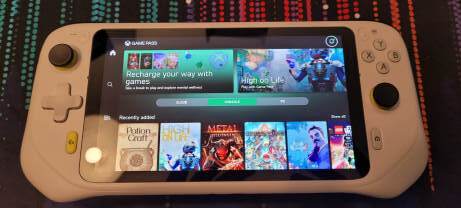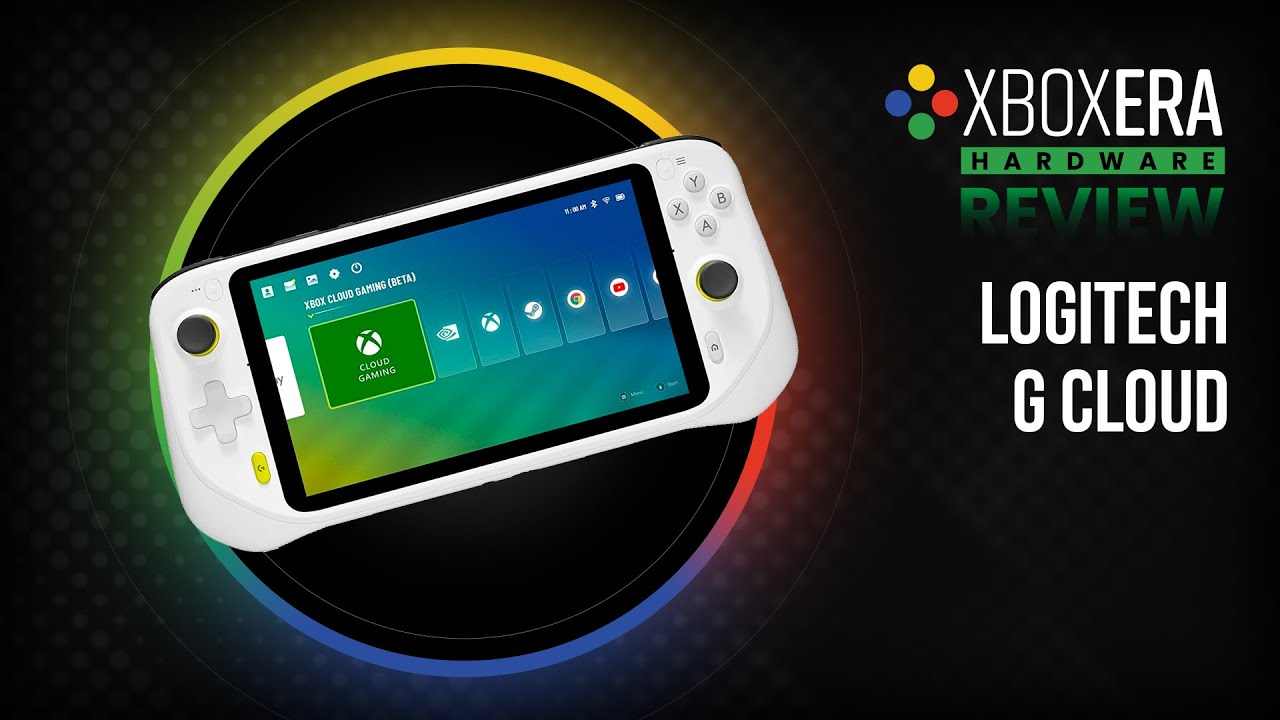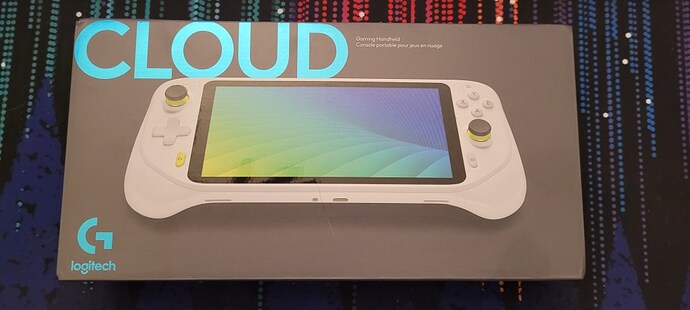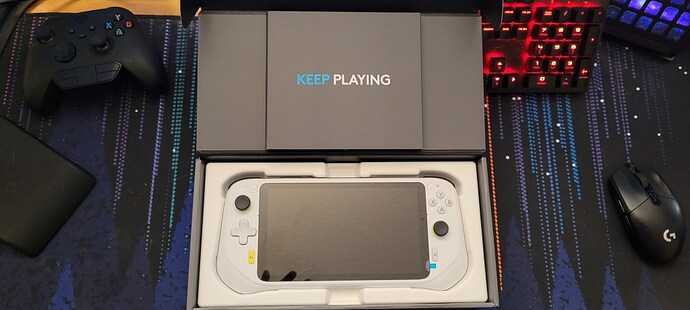Originally published at: Review | Logitech G Cloud Gaming Handheld - XboxEra
Logitech sent us a G Cloud unit roughly three weeks ago. I was originally skeptical about a $350 dollar Android tablet built into a controller. After using the device for a few dozen hours though I see the appeal. The quality is high, and the battery life is incredible. There are some issues to go along with the positives. The interface needs some work, and performance on native android titles can be rough. This is marketed as a cloud device first and foremost though, and in that area, it shines.
The Device Itself
Out of the box I was impressed with the build quality of the G Cloud. You can see the seams where it is put together, but the device feels like a tank. High-quality plastics are met with a comfortable shape, and the lack of powerful internal hardware helps the unit feel light in the hands. Let’s do a breakdown of the specs and then cover each major area of the device’s hardware:
| CPU | Qualcomm Snapdragon 720G (SD720G) Octa-core CPU up to 2.3GHz |
| Internal Memory | 64GB of ROM |
| Display Resolution | 1920×1080 |
| Display Type | IPS LCD |
| Max Brightness | 450 Nits |
| Display Size | 7” Diagonal |
| Refresh Rate | 60 Hz |
| Touch Capabilities | Multi-Touch |
| Speakers | Two Bottom Firing |
| Microphone | Dual Front Facing |
| Headphone Support | 3.5mm Stereo Headset/Microphone Jack |
| Controls | Full Xbox Pad Setup + G and Home Buttons for UI |
| Volume | Up and Down Control Buttons |
| Power | Sliding Switch |
| “Sense Control and Haptics | Linear Haptics, 6-axis IMU sensor, Ambient light sensor |
| Wi-Fi | Dual-band Wi-Fi radio, 2.4GHz and 5GHz, 2 x 2 MIMO, IEEE 802.11a/b/g/n/ac |
| Bluetooth | Bluetooth 5.1 |
| Charging Port | USB Type C |
| Battery Type | Rechargeable Li-Polymer |
| Battery Watt Hours | 23.1 |
| Estimated Battery Life | 12+ Hours |
| Expansion | Micro-SD Card Slot |
The first thing most tech-heads will notice is the older, weaker Chipset used. For a $350 item, you would hope for something newer, so that current mobile titles could take advantage of the full capabilities of the display. With the focus on cloud gaming and the complete lack of any way to monetize the product after purchase, I can see why Logitech cut costs where possible. Internally there is a 64 GB ROM cheap, but you’ll only have access to roughly 30GB or so out of the gate. This wasn’t a major issue until I went to install larger/more power-hungry titles like Diablo: Immortal. It ran decently but filled up the entirety of the internal storage by itself. The micro-sd card slot available helps alleviate this, as card prices have dropped to absurdly low numbers in recent years.
I think that the display is fantastic, and the 450-nit peak brightness was a massive help when using the G Cloud outside during the day. It is only 60 Hz, but once again with the focus on streaming and weak internal hardware a higher refresh rate panel would end up using more power but rarely be taken advantage of. The 7” size on the display worked well for my aging eyes most of the time. After extended play sessions, I did feel the need to move the device closer, but my vision is pretty terrible, and your mileage may vary. The control setup is both interesting and disappointing. This is an android device through and through, and Android doesn’t know how to interact with a controller. Anything done at a system level that requires typing or use of a keyboard at all will make you use the touch controls. Even unlocking the device required me to tap in a code on the screen instead of being able to use the Xbox controller that is built into the unit.
That controller feels well made, but for small hands. I, unfortunately, have huge hands, and the cramped setup of the face buttons on the right side led to some serious cramping after an hour or less in most games. The quality of the buttons, sticks, bumpers, and triggers is high with the triggers being fully analog as well. Connection-wise both the Wi-Fi and Bluetooth never dropped from my router and earbuds respectively, and the biggest and best-selling point of the device is the battery life.
Logitech claims twelve-plus hours, but in my usage, I routinely hit over fifteen when the device was set to half screen brightness and volume. This is of course while streaming games over Xbox Game Streaming or Steam. Playing Diablo Immortal did tear through my battery, going from 100% to 5% in roughly five hours. That’s still damn respectable and lowering screen brightness at night made things last even longer. Let’s get into the software side of the device now.
Tencent Built Logitech A Launcher
After an easy setup process familiar to anyone with an Android device you will be greeted with a new launcher that Tencent, Microsoft, and Logitech worked on together. It’s a simplified one that allows only one app to run at a time. This is due in large part to the device only having 4 GB of RAM available for the system. It’s clean looking on the front end, but messy when you dive deeper into it. I logged into my google account that is tied to my phone. The G Cloud asked if I wanted to sync with my normal apps and I told it yes. Within 10 minutes my device was full of everything I had installed currently on my phone. It was neat to see but led to me deleting a ton of apps that are only useful on a cellular-enabled device. The G Cloud is a North American-only Wi-Fi device, so Waze and other on-the-go GPS-style applications were useless.
Another key issue is how long it takes to swap between this cloud gaming-focused launcher and the regular tablet mode. It felt like no less than 20 button presses to get into the UI and swap between them when it should be a two-press process. There are home and G buttons on the device, which are how you navigate the UI without having to swipe the screen. I hope they bring a swap between-modes feature into one of these single buttons press menus in the future.
Despite having a USB C port on the bottom there is also no way to capture footage in game mode. You can take snapshots easily enough, but capturing footage requires going into tablet mode and finding a third-party screen capture app. Every one that I tried hurt performance severely in natively run Android titles but worked well enough on cloud-based games.
I would call my experience on the device functional. As a tablet it works fine but has no stand built into the back, so watching videos requires holding it the entire time. For gaming use, you must use the touch screen repeatedly for the UI whenever typing is involved, and further work with Android and TenCent to try and improve this is a must. I mostly played Xbox’s Game Pass Cloud Streaming with my review unit, and it worked like a dream at home and horribly on the road. Whenever I was home the device worked perfectly, with input lag so small that I didn’t notice it after 10 minutes. At my sister-in-law’s for Thanksgiving, it ran terribly on their home internet. Every time I tried using it through a hotspot to my T-Mobile service it refused to function on 4G and in the few areas I got 5G the input lag was immediately off-putting. When it works it feels native, but that required a specific setup in my case and is an impossible thing to test for everyone.

In Conclusion
The Logitech G Cloud Gaming Handheld is a well-made device that feels like a proof of concept for what the future of mobile gaming can be. It’s made by a company that doesn’t own any of the application stores that function on it though, and that leads to an eye-watering MSRP. It has routinely been on sale for $50 to $100 off since launch though, and if you have Xbox Game Pass, Nvidia’s G-force Now, or a PC to use Steam Link with then there is no other device like it on the market.


